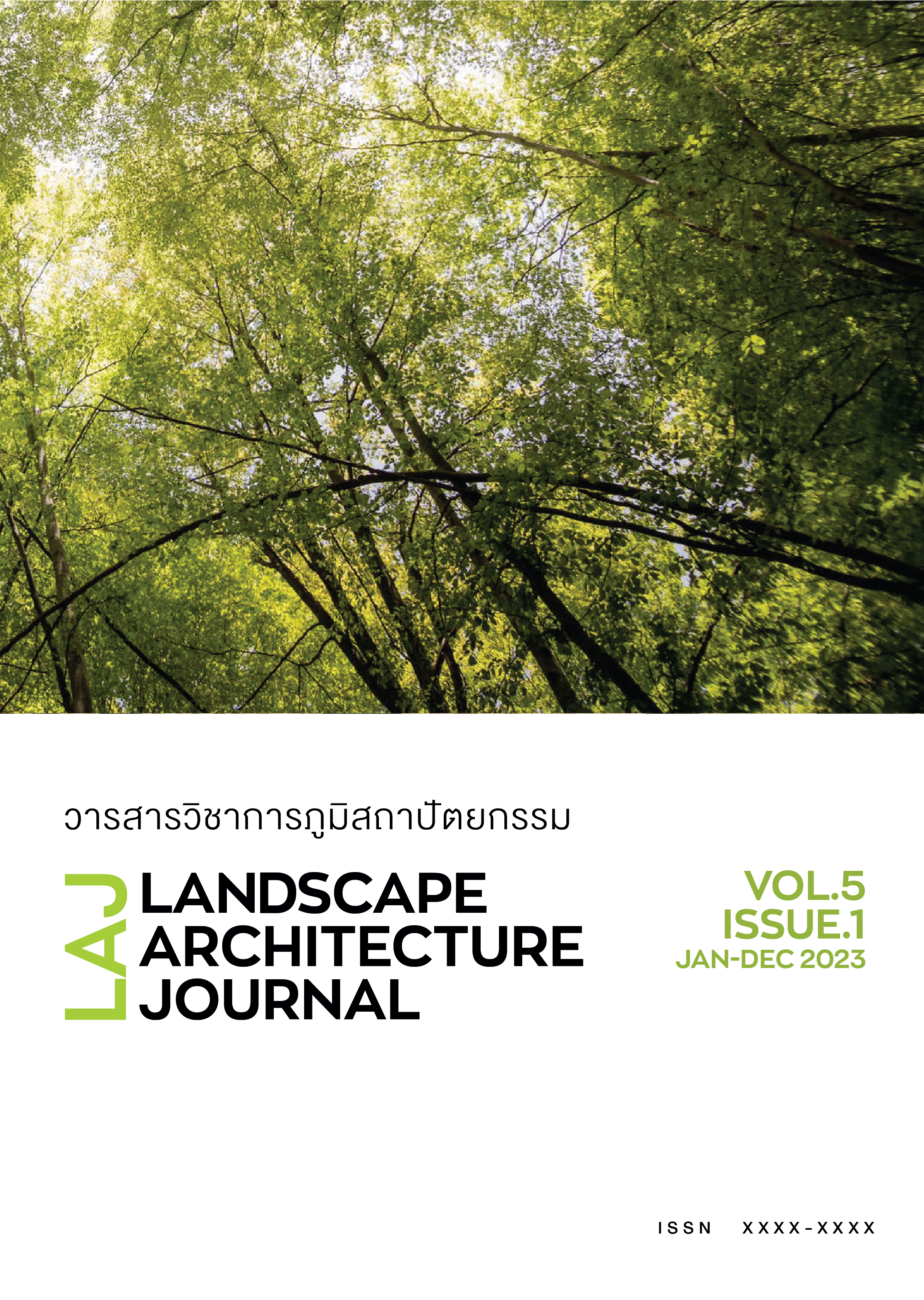Museum Site Selection: Case Study of the National Exhibition of Art Museum
Main Article Content
Abstract
This article investigated the process of site selection in museum design under the project to define the Competition Conditions for the National Exhibition of Art Museum to Celebrate Bangkok’s 250th Anniversary. The study reviewed related literature on the relationship between museums and sites to understand the characteristics of museums in different locations and the criteria for museum site selection. The information was used for the site selection process of the National Exhibition of Art Museum project. The study found that the site has incredible influences on the characteristics and functions of a museum. Accordingly, the museum site selection process must be addressed in two levels. The first level is to define the museum’s characteristics regarding its location. This macro-scale selection considers
the concept, the related policies, and the goals of the museum. The second level is the micro-scale site selection linked to the concerns in museology and museum landscape design. The social, economic, and environmental conditions must be equally taken into consideration. The findings of this study will be presented in the Guidelines for Writing Architectural Competition Term of Reference (TOR) for Thai Government Projects.
Article Details

This work is licensed under a Creative Commons Attribution-NonCommercial-NoDerivatives 4.0 International License.
References
กุณฑิกา ชาพิมล และ ดีอนา คาซา. (2565). พลวัตของพิพิธภัณฑ์ไทย: ความหมายใหม่ในสถานที่เดิม. วารสารศิลปศาสตร์ มหาวิทยาลัยธรรมศาสตร์, 22(3), 355-370.
คณะสถาปัตยกรรมศาสตร์ จุฬาลงกรณ์มหาวิทยาลัย (2542). รายงานฉบับสมบูรณ์ โครงการวิจัยเรื่องการสำรวจเตรียมการก่อสร้างที่ทำการรัฐสภาแห่งใหม่, กรุงเทพฯ : คณะสถาปัตยกรรมศาสตร์ จุฬาลงกรณ์มหาวิทยาลัย.
ชัยสิทธิ์ ด่านกิตติกุล. (2562). การเลือกที่ตั้งโครงการ, กรุงเทพฯ: โรงพิมพ์ เจ ปริ้นท์.
ฐาปกรณ์ ทองคำนุช, เกษวดี พุทธภูมิพิทักษ์ และอรวรรณ ศิริสวัสดิ์ อภิชยกุล. (2564). การส่งเสริมการท่องเที่ยวเชิงพิพิธภัณฑ์ในประเทศไทยด้วยแนวคิดพิพิธภัณฑ์จุดหมายปลายทาง. วารสารบัณฑิตศึกษา มหาวิทยาลัยราชภัฏวไลยอลงกรณ์ ในพระบรมราชูปถัมภ์, 15(1): 38-52.
ธนพล วัฒนจินดาเลิศ และเทิดศักดิ์ เตชะกิจขจร. (2561). บทเรียนจากงานปรับปรุงอาคารอนุรักษ์ริมถนนราชดําเนิน: กรณีศึกษาอาคารนิทรรศน์รัตนโกสินทร์ และ หอสมุดเมืองกรุงเทพฯ. สาระศาสตร์, 1(2): 337-348.
ธาดาพัฒน์ ลิมาภรณ์วณิชย์. (2564). เทคโนโลยีที่สนับสนุนการเรียนรู้ในพิพิธภัณฑ์. วารสารครุศาสตร์อุตสาหกรรม, 21(2): C1-C15.
สมชัย สราญสิริบริรักษ์ และ สุภาภรณ์ จินดามณีโรจน์. (2559). รูปแบบการจัดตั้งพิพิธภัณฑ์บริษัทการบินไทย. Veridian E-Journal ฉบับภาษาไทย สาขา มนุษยศาสตร์ สังคมศาสตร์ และศิลปะ, 9(3): 1350-1369.
สํานักงานสภานโยบายการอุดมศึกษา วิทยาศาสตร์ วิจัยและนวัตกรรมแห่งชาติ และสํานักงานคณะกรรมการส่งเสริมวิทยาศาสตร์ วิจัยและนวัตกรรม (2562). นโยบายและยุทธศาสตร์การอุดมศึกษา วิทยาศาสตร์ วิจัยและนวัตกรรม พ.ศ. 2563-2570 และแผนด้านวิทยาศาสตร์ วิจัยและนวัตกรรม พ.ศ. 2563-2565.
Johanson, L. B. and Olsen, K. (2010). Alta Museum as a Tourist Attraction: The Importance of Location. Journal of Heritage Tourism, 5(1): 1-16.
Kochergina, E. (2017). Urban Planning Aspects of Museum Quarters as an Architectural Medium for Creative Cities. IOP Conference Series: Materials Science and Engineering, 245 (052031): 1-12.
Martha, L. and A. Kotsaki (2015). The Museum Culture as a Means of Conjunction of the Urban and Rural Environment. Procedia - Social and Behavioral Sciences, 175: 601-606.
Paül i Agustí, D. (2014). Differences in the Location of Urban Museums and their Impact on Urban Areas. International Journal of Cultural Policy, 20(4): 471-495.
Rautenstrauch, B. (1974). Siting: Study and Choice of the Site. Museum International, 26(3-4): 135-156.
Sae-Wang, R. (2017). Cultural Heritage Management in Thailand: Common Barrier and the Possible Way to Survive. Humanities, Arts and Social Sciences Studies, 17(2), 133-159.
Sasaki, M. (2010). Urban Regeneration through Cultural Creativity and Social Inclusion: Rethinking Creative City Theory through a Japanese Case Study." Cities 27: S3-S9.
Silberberg, T. (2012). Manual of Museum Planning: Sustainable Space, Facilities, and Operations. Maryland: AltaMira Press.
Tien, C-C. (2010). The formation and impact of museum clusters: two case studies in Taiwan. Museum Management and Curatorship, 25(1): 69-85.

